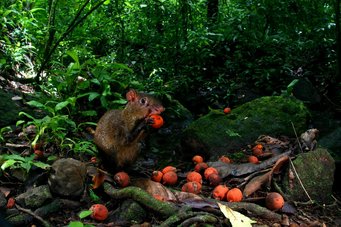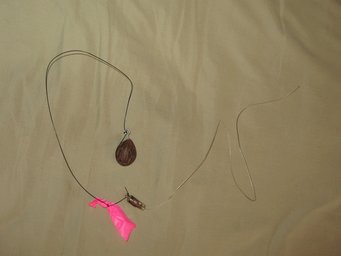Thieving rodents as saviours of tropical trees
Agoutis disperse tree seeds in the rain forest of Latin America
The Neotropics of Central and Southern America have many plant species with especially big fruits which were probably once ingested and then defecated by huge mammals of the Pleistocene that dispersed the seeds over large distances. But these huge mammals were most likely hunted to extinction more than 10,000 years ago. This raises the question why large-seeded plants aren’t also extinct. Even though rodents have been known to be poor dispersers, Patrick Jansen of the Smithsonian Tropical Research Institute in Panama, Martin Wikelski of the Max Planck Institute for Ornithology in Radolfzell and their colleagues have shown that the tropical rodent Agouti Dasyprocta punctate has taken over the role of the seed dispersers. By video-monitoring the caches and attaching radio transmitters to more than 400 fruits, they found out that the rodents steal seeds from one another and hide them repeatedly. The seeds then finally end up to 280 metres away from their starting point.

Successful seed dispersal is essential for plants and a critical requirement for them to persist in the face of predators and illnesses. Additionally, plants need long-distance seed dispersal to maintain gene flow between populations and colonize new sites. The tropical forests of Central and South America are rich in woody plant species with large-seeded fruits that are structurally similar to fruits of trees of the Paleotropics, the tropical regions of Asia and Africa which were dispersed by megafauna (mammals weighing more than one ton). Ecologists have therefore argued that the plant species of the Neotropics were adapted to a megafauna seed-dispersal such as that of gomphotheres, a prehistoric elephant which became extinct 10,000 years ago at the end of the Pleistocene.
One can question whether the Neotropical forests were actually dependent on the megafauna due to the fact that they still thrive without their disperser. Patrick Jansen and Roland Kays, scientists at the Smithsonian Tropical Institute and Martin Wikelski of the Max Planck Institute for Ornithology and their colleagues have investigated to see if agoutis have taken over the role of the gomphotheres.
This rodent species, the size of a rabbit, is common in the forests of Panama. It buries its seeds as food reserves in shallow caches, each containing one or two seeds. The seeds are protected and have ideal germination conditions. However, Agoutis dig out the hidden fruits and rebury them at a new site. They often loot most of the seeds they cache, so possibly no seeds are buried long enough to establish a seedling.
Thus, available data would suggest that rodents are not effective seed dispersers especially because the Agoutis transport the seeds such short distances that the chance of colonizing a new site and escaping intense competition is rare.

The scientists working with Patrick Jansen wanted to calculate the distance that the rodents actually disperse seeds, the journey that the seeds take, and see if the Agoutis serve as a replacement seed disperser for the extinct megafauna. They attached miniature radio tags to 500 seeds of a palm tree species. 85 percent of the tagged seeds were carried away and initially buried a few meters away from the starting point.
Video surveillance of the caches showed that most of the seeds were removed, not eaten, but instead carried further and reburied. This procedure was repeated an average of 8 times by different species; 84% of the seeds were stolen by other Agoutis. The seeds moved a distance of about 900 metres in this process. “One seed was cached as many as 36 times, travelled more than 749 m, and ended 280 m from its starting point,” reported Patrick Jansen, “when it was dug up and eaten by an agouti 209 days after initial dispersal.” Approximately 35% of the seeds ended more than 100 meters from their starting point.
By the time new fruits ripened in the following year and the rodents lost interest in the old stock, approximately 14% of the seeds survived. “Our results indicate that rodents may disperse seeds over much longer distances than was ever anticipated,” said Patrick Jansen, “they are effective seed-dispersers.” They cannot carry the seeds over long distances, as the prehistoric megafauna did, but the survival potential of the scatter-hoarded seeds is likely superior to that of hundreds of seeds deposited together in a gomphotheres dung pile.
The secondary seed dispersal caused by the repeated burying and stealing of seeds could be an explanation for the survival of neotropical trees with large fruits such as cashews since the relationship between rodents and nut-carrying trees is much older than Pleistocene.
LA/HR

